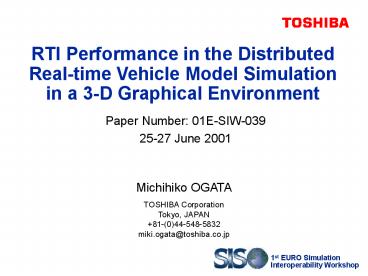01ESIW039 Paper
1 / 29
Title: 01ESIW039 Paper
1
RTI Performance in the Distributed Real-time
Vehicle Model Simulation in a 3-D Graphical
Environment
Paper Number 01E-SIW-039 25-27 June 2001
Michihiko OGATA TOSHIBA CorporationTokyo,
JAPAN81-(0)44-548-5832miki.ogata_at_toshiba.co.jp
2
Why are we doing this?
- Situation
- We built a prototype of the real-time detailed
model simulation in a 3-D graphical environment - However,
- The performance of our simulation depends on the
performance of RTI - Need to examine and evaluate the performance of
RTI
3
Overview
- About our simulation
- What is our vehicle model simulation?
- Architecture
- Performance of RTI using our models
- Objective of performance
- Test and evaluation
- Conclusion and future plans
4
About our simulation
5
General characteristics
- Detailed real-time vehicle models
- Situational awareness
- Command and control
- Decision making
- Route planning
- Distributed environment
- HLA interface
- HCI (Human computer interface)
- 2D/3D situation display
6
Architecture
7
Federation architecture
8
Situation displays
9
Performance of RTI using our models
10
Objective of performance
- Keep real-time processing
- with real-time 3-D situation desplay
- Data refresh rate
- 30Hz and above
- Examine and evaluate with DIS and RTI-NGs
- Data refresh rates
- RTI time delay
- CPU loads
- Joining time
- Stability
11
Situations and solutions
- Situation
- Data refresh rate was 30Hz and above with DIS
- It fell to 1Hz using RTI time management service
with DMSO RTI-NGv1 - Solution
- Built our original time management system with
wall clock instead of using RTI time management
service - Used periodical time synchronization between
federates by NTP (Network Time Protocol) and
asynchronous operation with each federate
12
Case 1 DIS - RTI-NGv1
- Experience
- Data refresh rate rose to around 30Hz
- Problems
- Cyclic delay for data refresh occurred
- Federates were hard to join to RTI with heavy CPU
loads - RTI was unstable
13
Case 2 RTI-NGv1 - RTI-NGv2
- Experience
- Cyclic time delay still occurred
- RTI was still unstable with federate joined
14
Case 3 RTI-NGv2 - RTI-NGv3
- Experience
- Data refresh rate became stable
- RTI was also stable
- Federates were easy to join to RTI
- We cleared our objective with performance
15
Case 4 RTI-NGv3 - RTI-NGv3.1
- Experience
- Data refresh rate was stable
- RTI was also stable
- Federates were easy to join to RTI
- We cleared our objective with performance
16
Case 5 RTI-NGv3.1 - RTI-NGv3.2
- Experience
- Data refresh rate was stable
- RTI was also stable
- Federates were easy to join to RTI
- We cleared our objective with performance
17
RTI Time Delay
() Test Condition Using DMSO Benchmark test
condition Number of federates 2 federate
Number of objects 1 object/federate Number
of attributes 1 attribute/object Size of
attributes 128 bytes/attribute Number of
updates 1000 times
18
CPU loads
19
Joining time (1/2)
- Case 1 DMSO RTI-NGv1
- It took 3 to 5 minutes
- The more federates that tried to join to RTI, the
more joining time was needed - Case 2 DMSO RTI-NGv2
- It took about 2 minutes
- The more federates that tried to join to RTI, the
more joining time was needed - Case 3 DMSO RTI-NGv3
- It took about 1 minute
- Joining time was stable
20
Joining time (2/2)
- Case 4 DMSO RTI-NGv3.1
- It took about 1 minute
- Joining time was stable
- Case 5 DMSO RTI-NGv3.2
- It took about 1 minute
- Joining time was stable
21
Stability (1/2)
- Case 1 DMSO RTI-NGv1
- Some Federates failed to join
- One federate could not recognize other federates
most of the time - Case 2 DMSO RTI-NGv2
- Some Federates failed to join
- One federate could not recognize other federates
sometimes - Case 3 DMSO RTI-NGv3
- All federates could join easily
- No problems were found
22
Stability (2/2)
- Case 4 DMSO RTI-NGv3.1
- All federates could join easily
- No problems were found
- Case 5 DMSO RTI-NGv3.2
- All federates could join easily
- No problems were found
23
Conclusion and future plans
24
Conclusion
- Experience
- Tried kinds of versions of RTI-NG
- Not found any great difference among NGv3,
NGv3.1, and NGv3.2 - Problems about test condition
- Minimum time of measure for benchmark test was 5
ms - Windows clock mechanism proved to be slightly
inaccurate - Lessons learned
- valuable lessons regarding our real-time
simulation
25
Future plans
- Continue to evaluate the most up-to-date version
of RTI using our models - Continue to evaluate our simulation with the most
up-to-date version of RTI - Several issues remain unsolved
- Work-in-progress
26
We hope that
- Our study find a better environment for real-time
detailed model simulation
27
Any Questions?
28
See you again on the next SIW!Thanks a lot.
29
Contacts
Michihiko OGATA TOSHIBA Corporation, Komukai
OperationsNetwork Systems Engineering Dept.1
Komukai-Toshiba-cho, Saiwai-kuKawasaki, Kanagawa
212-8581JAPANPhone 81-(0)44-548-5832Facsimile
81-(0)44-548-5947E-mail miki.ogata_at_toshiba.co
.jp
Akira HIGASHIDEakira.higashide_at_toshiba.co.jp
Toshinao TAKAGItakagi_at_yk.toshiba-tesco.co.jp
Kenji IMAIimai_at_yk.toshiba-tesco.co.jp































